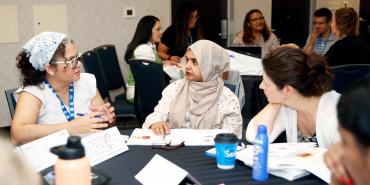Supporting English language learners requires more than access to resources; it demands a multifaceted approach rooted in equity, cultural respect, and connection with students and families to understand and meet students’ individual needs. During a Friday morning session at the AFT TEACH conference, “ELL 101: A Beginner’s Guide to Effective Strategies and Approaches,” participants learned and shared research-based strategies to better serve this growing student population.
Following an icebreaker in which participants drew connections with each other based on their lived experiences (a great classroom activity to highlight the importance of stories and help students find common ground), AFT national trainer Susan Lafond and bilingual instructional coach Carol Pagan presented the following six components of working successfully with ELLs and their families. They also shared associated approaches grounded in real school-based experiences.
1. Engaging in policy and advocacy
As educators increasingly see federal funds and resources clawed back from schools, it is essential to know what works for instruction in English language development. Evidence-based instructional practices, such as devoting daily blocks to ELD instruction and explicit instruction that emphasizes academic as well as conversational language, can help students become proficient in English. Further, understanding the distinction between equality and equity can guide educators as they design instruction and advocate for the supports and accommodations that students need to be engaged and empowered in learning.
2. Scaffolding second language acquisition
Many factors influencing successful second language acquisition—such as age, prior knowledge and first-language proficiency—are outside an educator’s control, but high-quality, intentional instruction that includes scaffolding is not. Educators can provide structured support early on and gradually remove these supports as students gain proficiency. It’s also important to be strategic in using accommodations; those that are not tailored to students’ unique needs or that establish hard-to-break habits may not best serve students.
3. Connecting culture and student achievement
The foundation of effective instruction for ELLs is built on teacher-student relationships. Getting to know students and understanding their backgrounds and individual needs can help educators tailor instructional strategies to increase students’ learning. Additionally, respecting and incorporating students’ cultural identities and values in the classroom promotes a sense of belonging; activities that encourage students to share their stories and make connections foster community and increase engagement.
4. Providing language and literacy instruction
Successful ELL instruction integrates the five components of literacy (phonemic awareness, phonics, vocabulary, fluency and comprehension) into scaffolded lessons. Incorporating practical strategies for each of these components—such as having students match pictures of words with the same beginning, middle and ending sounds; pre-teaching vocabulary; building background knowledge; and giving students practice in reading aloud—into approaches such as gradually releasing responsibility can differentiate language instruction and support ELLs who are learning to read.
5. Planning for student success
Motivation and engagement are the building blocks for student achievement. Teachers must plan lessons that hook students’ interest, build on their background knowledge and challenge them appropriately. Using team-building games and activities, including diverse reading materials and integrating technology (such as apps like Classkick) to incorporate students’ voices and choices can empower ELLs to participate and become engaged in their learning.
6. Increasing family engagement
Finally, true success with ELLs involves meaningful family engagement, including improving communication and providing opportunities for families to partner in learning. Platforms like TalkingPoints and SchoolStatus can help educators communicate with families, and intentionally designed outreach can help families move beyond just helping or volunteering at school events to collaborating on learning goals and co-developing strategies for student success.
ELL 101 was adapted from an extensive AFT professional learning course developed by and for classroom practitioners. To learn more about this training, email Giselle Lundy-Ponce at glundypo@aft.org.
[Lesley Gonzalez]

